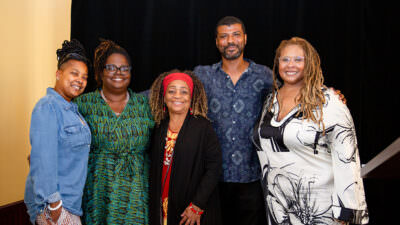
In their book Happy Money, researchers Elizabeth Dunn and Michael Norton use scientific research to explore the relationship between money and happiness, offering insights into how spending money can contribute to greater well-being. The authors argue that the way we spend money is often more important than how much money we have, highlighting several key principles for using money to enhance happiness.
It should come as no surprise to supporters of Berkshire Taconic Community Foundation that one takeaway from the research is that we ought to consider “investing in others.” Spending money on others through gifts or charitable donations can foster a sense of connection and fulfillment. The book provides examples of how spending money on others can increase happiness. For instance, giving gifts to loved ones or donating to charity can evoke feelings of joy and fulfillment. Research cited in the book shows that people experience a "warm glow" when they contribute to the well-being of others, which enhances their own happiness and sense of connection with others.
As our economic inequality grows ever wider, charitable giving is more important than ever. Let’s continue to foster that sense of community. Berkshire Taconic offers a range of options and unparalleled expertise in charitable giving for those who want to maximize their impact. In this brief article, I will explore two gifting strategies that people I have worked with have found especially valuable (this only scratches the surface of ways you can help).
Qualified Charitable Distributions (QCDs)
If you're 70½ or older and have a traditional IRA, a qualified charitable distribution (QCD) could be the ideal opportunity to support causes you care about. A QCD allows you to donate directly from your IRA to a qualified charity, including a field-of-interest, designated, unrestricted, or scholarship fund at Berkshire Taconic, and the amount you give doesn’t count as taxable income. That’s a win-win: you make a difference and potentially lower your tax bill at the same time.
If you haven’t yet satisfied your required minimum distribution (RMD) yet for 2024, a QCD can be used to satisfy all or part of it. The maximum QCD for 2024 is $105,000. Instead of taking the distribution as income, which might push you into a higher tax bracket, you can direct that money to charity. Plus, even if you don’t itemize deductions on your tax return, you can still benefit from the reduction in taxable income. It's a simple, effective way to make a meaningful impact without cutting into your cash flow or other assets.
If you’re thinking about making a QCD in 2024, talk to your financial advisor to get started before the December 31 deadline.
Moving into 2025, there may be a way to make QCDs even easier. Many IRA custodians such as Charles Schwab or Fidelity offer the option to set up a checkbook for qualified charitable distributions, making it easier for you to give directly to charities. With this feature, the custodian issues a checkbook linked to your IRA, allowing you to write checks directly to eligible charitable organizations, including BTCF. Once the nonprofit deposits the check, the custodian processes it as a distribution. This method simplifies the process, giving you more control over the timing and amounts of your donations. To get started, contact your IRA custodian and ask if they provide this service—it’s a convenient way to manage your QCDs throughout the year.
Bunching Gifts
Bunching is another strategy that can help maximize tax benefits while supporting the causes you care about. Bunching means combining multiple years' worth of charitable donations into one tax year to surpass the standard deduction and take advantage of itemizing your deductions. In the following year(s), you can take the standard deduction again, effectively alternating between itemizing your deductions and taking the standard deduction. This strategy allows you to maximize the tax impact of your generosity without having to change how much you give overall.
For example, instead of donating $10,000 annually for three years, you could give $30,000 in a single year and itemize your deductions that year. The next year, you can revert to the standard deduction. To make the most of bunching, Donor Advised Funds (DAFs) can be a helpful tool. A DAF lets you make a large donation in one year for the tax benefit, while still spreading out the actual gifts to charities over time. This flexibility ensures your giving aligns with your philanthropic goals while also being tax efficient.
The Tax Cuts and Jobs Act of 2017 doubled the standard deduction amount. This means that most taxpayers now utilize the standard deduction instead of itemizing deductions. Many who itemize deductions may find themselves only marginally above the standard deduction threshold. For these people, bunching can be an especially savvy tax maneuver. Get a big, itemized tax deduction this year, and then switch to the standard deduction next year. You might even choose to bunch several years’ worth of gifts at once. The stock market is near an all-time high, making this an excellent time for many donors to consider adding to their Donor Advised Fund at Berkshire Taconic to bunch their donations.
Tax Savings…Wooo!
I’ll admit I get a weird sense of satisfaction finding ways to reduce income taxes. Doing so by giving to organizations like Berkshire Taconic Community Foundation is icing on the cake. While I’ve explored just two options in this article, the team at Berkshire Taconic offers many good ideas about ways you can give.
Let’s make the biggest impact we can in 2024 and start making plans for 2025, too.
----
Luke Delorme is a Certified Financial Planning® professional with Tableaux Wealth in Stockbridge. Luke has a Bachelor of Science in Economics and an MBA from Boston College, where he received the Wall Street Journal award for the top finance student. He lives in Great Barrington with his wife, two daughters, and dog Yogi. If you live in the Berkshires, you've likely seen him running or biking year-round.




